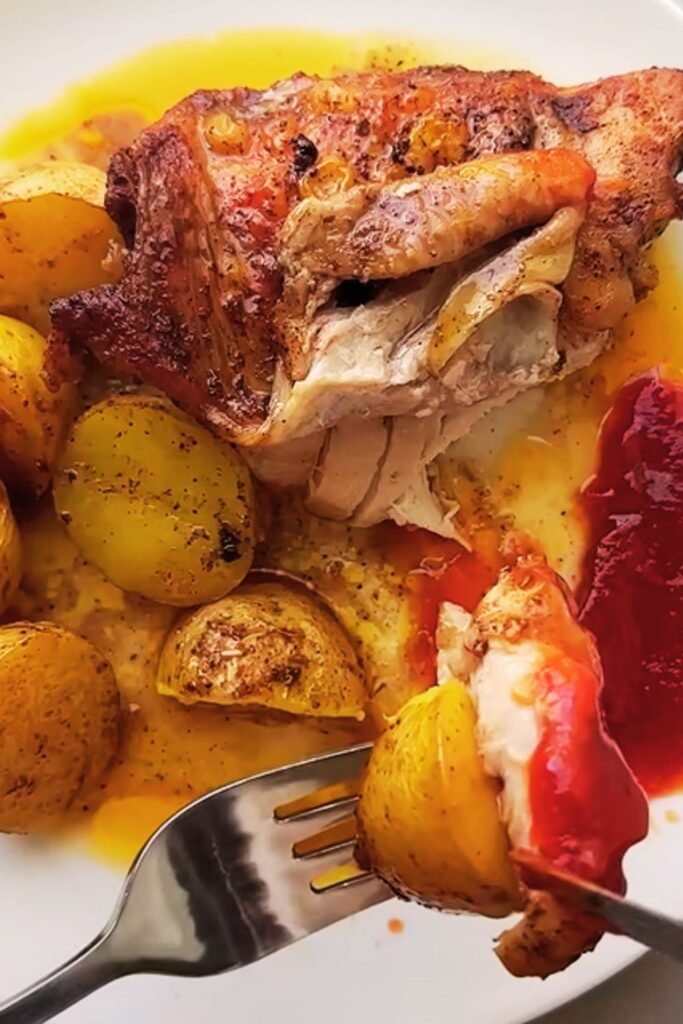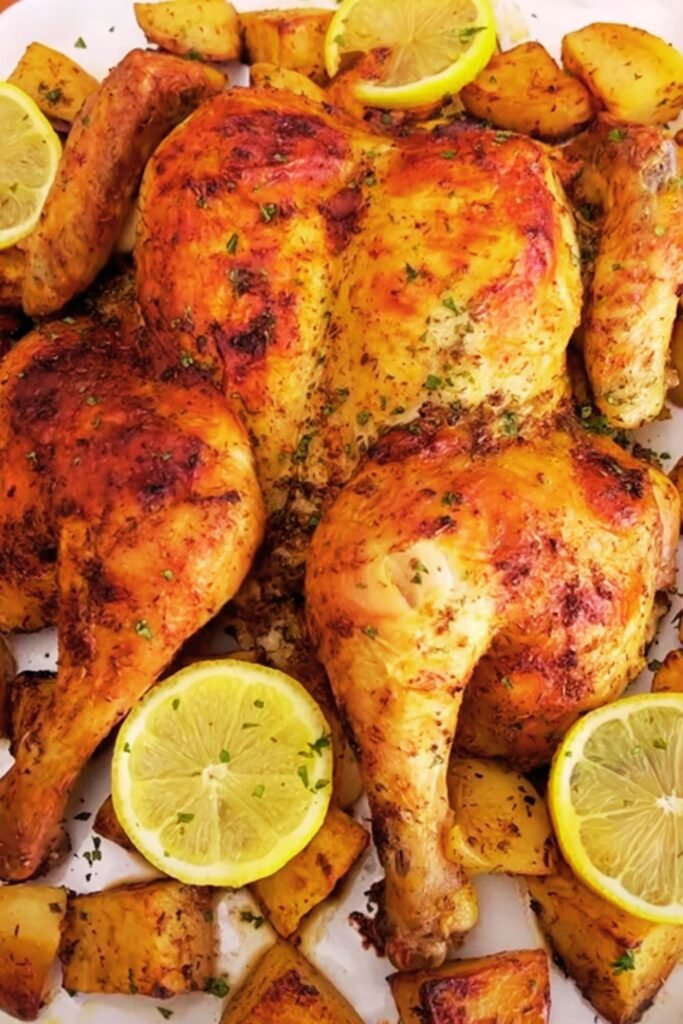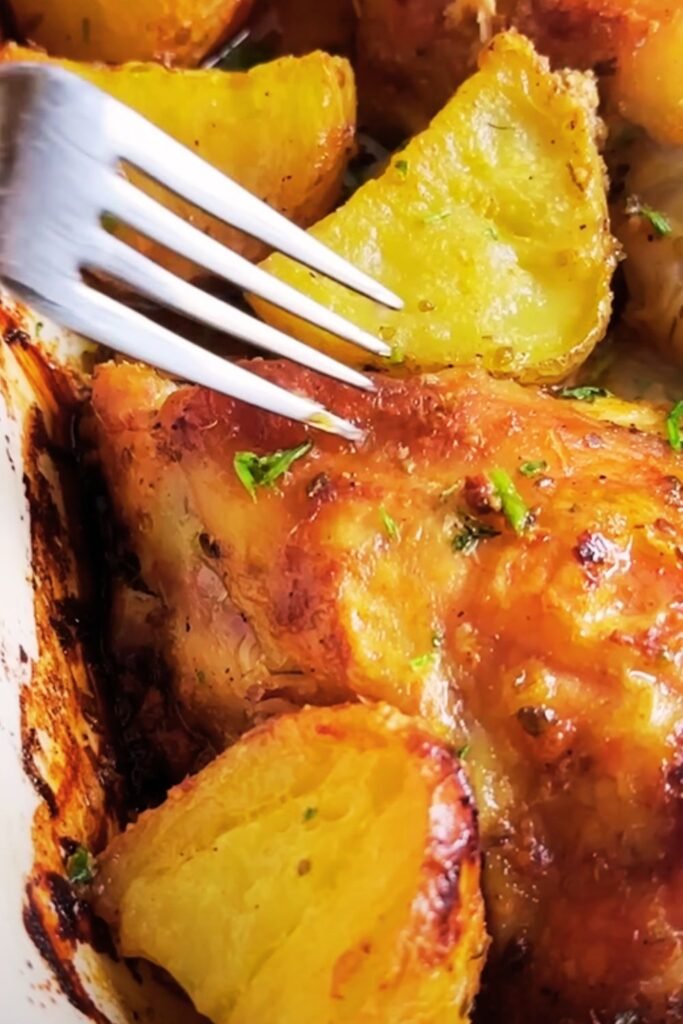When I first discovered the magic of using a bundt pan for roasting chicken, my entire approach to weeknight dinners transformed. This isn’t just another chicken recipe – it’s a game-changing method that delivers perfectly cooked, juicy chicken with crispy skin while simultaneously roasting vegetables to golden perfection. The bundt pan’s unique design creates the ideal environment for even heat distribution, resulting in restaurant-quality Greek flavors right from my home kitchen.
The beauty of this recipe lies in its simplicity and the way traditional Greek flavors meld together during the roasting process. I’ve refined this technique over countless family dinners, and it never fails to impress guests while requiring minimal hands-on time. The bundt pan method ensures that the chicken stays incredibly moist while the vegetables develop those coveted caramelized edges that make every bite memorable.
Understanding the Bundt Pan Advantage
Bundt Pan Cooking: A method of roasting that utilizes the central tube of a bundt pan to create optimal heat circulation around proteins while vegetables cook in the surrounding well.
Greek Flavor Profile: The combination of olive oil, lemon, oregano, garlic, and Mediterranean herbs that creates the distinctive taste associated with Greek cuisine.
One-Pan Roasting: A cooking technique that allows proteins and vegetables to cook simultaneously in the same vessel, creating layers of complementary flavors.
The bundt pan’s design isn’t just aesthetically pleasing – it’s functionally brilliant for roasting. The central tube acts like a heat conductor, ensuring the chicken cooks evenly from the inside out while the vegetables nestle perfectly around the perimeter. This configuration prevents overcrowding and allows each component to develop its own character while contributing to the overall flavor harmony.
Essential Ingredients and Their Roles
Protein Selection
I always choose a whole chicken weighing between 3.5 to 4 pounds for this recipe. The size matters because it needs to fit comfortably over the bundt pan’s central tube while leaving adequate space for vegetables. Free-range or organic chickens tend to have better flavor and texture, though any quality whole chicken will work beautifully.
Vegetable Medley
My go-to combination includes:
- Baby potatoes or fingerlings, halved lengthwise
- Red onions, cut into thick wedges
- Bell peppers in vibrant colors, sliced into strips
- Zucchini rounds, cut thick to prevent overcooking
- Cherry tomatoes, left whole for bursts of concentrated flavor
- Kalamata olives for authentic Greek character

The Greek Seasoning Foundation
The marinade and seasoning blend forms the heart of this dish’s authentic flavor profile. I combine extra virgin olive oil with fresh lemon juice, creating an emulsion that penetrates both the chicken and vegetables. Dried oregano provides that unmistakable Greek aroma, while fresh garlic cloves infuse everything with robust flavor.
Detailed Cooking Method
Preparation Phase
I begin by preheating my oven to 425°F (220°C), which provides the high heat necessary for achieving crispy chicken skin while properly roasting the vegetables. The bundt pan gets a light coating of olive oil to prevent sticking and encourage browning.
The chicken requires careful preparation. I pat it completely dry with paper towels – moisture is the enemy of crispy skin. Using my fingers, I gently separate the skin from the breast meat, creating pockets where I can massage seasoning directly onto the meat. This technique ensures flavor penetration beyond just the surface.
Seasoning Application
My signature Greek seasoning blend consists of:
- 2 tablespoons dried oregano
- 1 tablespoon kosher salt
- 1 teaspoon freshly ground black pepper
- 1 teaspoon garlic powder
- 1 teaspoon onion powder
- ½ teaspoon dried thyme
- ¼ teaspoon red pepper flakes
I rub this mixture both under and over the skin, ensuring every surface gets attention. The cavity receives a generous sprinkle as well, along with halved lemon quarters and fresh herb sprigs that will perfume the meat from within.
Assembly Technique
The bundt pan assembly requires a specific order for optimal results. First, I arrange the heartier vegetables – potatoes and onions – in the bottom of the pan. These need the longest cooking time and benefit from direct contact with the pan’s surface for proper browning.
The seasoned chicken gets positioned carefully over the central tube, breast-side up. The tube supports the bird while allowing heat to circulate through the cavity. I tuck the wing tips under the body to prevent burning and tie the legs loosely for even cooking.

The remaining vegetables layer around the chicken, with delicate items like zucchini and tomatoes added later in the cooking process to prevent overcooking. A final drizzle of olive oil and lemon juice over everything creates the foundation for beautiful caramelization.
Temperature Guidelines and Timing
| Cooking Phase | Time | Internal Temp | Pan Position |
|---|---|---|---|
| Initial Roasting | 25 minutes | 120°F | Upper-middle rack |
| Vegetable Addition | 15 minutes | 140°F | Same position |
| Final Phase | 15-20 minutes | 165°F | Same position |
| Resting Period | 10 minutes | 170°F | Countertop |
The initial high-heat phase develops the chicken’s golden skin while beginning the vegetable cooking process. I monitor the internal temperature using a reliable meat thermometer inserted into the thickest part of the thigh, avoiding bone contact.
At the 25-minute mark, I carefully add the more delicate vegetables that don’t require the full cooking time. This staggered approach ensures everything finishes simultaneously without any component becoming overcooked or mushy.
Flavor Development Techniques
Basting Strategy
Every 20 minutes, I baste the chicken with the accumulated pan juices, which by now have become rich with rendered chicken fat and vegetable essences. This basting not only keeps the meat moist but also helps develop deeper flavor layers and promotes even browning.
Aromatics Enhancement
During the final 15 minutes, I add fresh herb sprigs – typically rosemary and thyme – directly to the pan. The high heat releases their essential oils, infusing the entire dish with fresh, aromatic complexity that dried herbs alone cannot provide.
Nutritional Benefits and Considerations
This cooking method preserves maximum nutritional value while creating incredible flavors. The vegetables retain their vitamins and minerals because they cook in their own juices mixed with healthy olive oil and chicken drippings. The skin-on chicken provides healthy fats while the lean meat delivers high-quality protein.
| Component | Calories (per serving) | Protein (g) | Fiber (g) | Key Nutrients |
|---|---|---|---|---|
| Chicken (4 oz) | 185 | 35 | 0 | B vitamins, selenium |
| Mixed Vegetables | 120 | 4 | 6 | Vitamins A, C, potassium |
| Olive Oil | 80 | 0 | 0 | Healthy monounsaturated fats |
| Total Per Serving | 385 | 39 | 6 | Complete amino acids |
Troubleshooting Common Issues
Preventing Dry Chicken
The most common concern with roasted chicken is dryness, but the bundt pan method naturally prevents this issue. The central tube conducts heat to the cavity while the surrounding design maintains moisture. However, I never skip the brining step for extra insurance – even a 30-minute salt water bath makes a significant difference.
Ensuring Even Vegetable Cooking
Vegetable sizes matter tremendously. I cut everything to similar dimensions, ensuring uniform cooking times. Root vegetables get cut smaller than softer vegetables to account for their longer cooking requirements.
Managing Pan Space
Overcrowding leads to steaming rather than roasting. If my bundt pan seems too full, I remove some vegetables rather than compromise the cooking method. Better to make a smaller batch that cooks perfectly than a large batch that turns out mediocre.

Serving Suggestions and Pairings
This complete meal requires minimal accompaniments, but I often prepare a few complementary sides that enhance the Greek theme:
- Warm pita bread for soaking up the delicious pan juices
- Tzatziki sauce made with Greek yogurt, cucumber, and fresh dill
- Simple Greek village salad with tomatoes, cucumbers, and feta
- Lemon rice pilaf that echoes the citrus notes in the main dish
- Roasted red pepper hummus as an appetizer
The presentation possibilities are endless. I sometimes garnish with fresh lemon wedges, scattered fresh herbs, and crumbled feta cheese for authentic Greek restaurant appeal.
Storage and Reheating Guidelines
Properly stored leftovers maintain their quality for up to three days in the refrigerator. I separate the chicken from the vegetables for optimal storage, keeping them in airtight containers to prevent drying out.
For reheating, I use a low oven temperature (325°F) rather than the microwave to preserve the textures. The chicken pieces benefit from a light brush of olive oil before reheating to refresh the skin’s crispiness.
Seasonal Adaptations
Spring brings opportunities to incorporate asparagus and fresh peas during the final cooking phase. Summer calls for additional tomato varieties and fresh basil. Fall welcomes butternut squash and Brussels sprouts, while winter adaptations might include root vegetables like parsnips and carrots.
Each seasonal variation maintains the core Greek flavoring while showcasing the best produce available. This flexibility keeps the recipe interesting throughout the year while building cooking confidence and creativity.
Advanced Tips for Perfect Results
Temperature Accuracy
I invest in a quality instant-read thermometer for precise temperature monitoring. The difference between perfectly cooked chicken at 165°F and overcooked chicken at 175°F is significant in terms of juiciness and texture.
Pan Preparation
A well-seasoned bundt pan or one with a good non-stick coating makes all the difference in cleanup and food release. I sometimes line the bottom with parchment paper for extra insurance, though it’s not strictly necessary with proper preparation.
Timing Coordination
Starting this dish requires planning since the total cooking time approaches an hour. I prepare all ingredients beforehand, allowing me to focus on monitoring and basting during the cooking process.
Frequently Asked Questions
Q: Can I use chicken pieces instead of a whole chicken? A: Absolutely! Chicken thighs work particularly well with this method. Arrange them skin-side up around the bundt pan’s center tube, adjusting cooking time to 35-40 minutes total. Bone-in pieces maintain moisture better than boneless options.
Q: What size bundt pan works best for this recipe? A: A standard 12-cup bundt pan provides the ideal space for a 3.5-4 pound chicken with vegetables. Smaller pans require smaller chickens or chicken pieces, while larger pans can accommodate bigger birds.
Q: How do I know when the vegetables are properly cooked? A: The vegetables should be tender when pierced with a fork but still hold their shape. Potatoes should be creamy inside with golden, slightly crispy exteriors. The cooking time naturally aligns with the chicken’s doneness.
Q: Can I prepare this dish ahead of time? A: The seasoning and initial preparation can be done several hours ahead, but the actual roasting should happen just before serving for optimal texture and temperature. However, the seasoned chicken can marinate in the refrigerator overnight for even deeper flavor.
Q: What if my bundt pan doesn’t have a non-stick coating? A: Regular aluminum or stainless steel bundt pans work fine with proper preparation. Grease thoroughly with olive oil or butter, and consider dusting with a light coating of flour or breadcrumbs to prevent sticking.
Q: How can I make this recipe spicier? A: Increase the red pepper flakes in the seasoning blend, add sliced jalapeños to the vegetable mix, or incorporate a pinch of cayenne pepper into the olive oil mixture. Fresh hot peppers can be added with the other vegetables.
Q: Is it necessary to brine the chicken first? A: While not absolutely necessary, a quick 30-minute brine in salt water significantly improves the chicken’s moisture retention and flavor. For time constraints, generous seasoning 30 minutes before cooking provides similar benefits.
Q: Can I use frozen vegetables? A: Fresh vegetables provide the best texture and flavor, but frozen vegetables can work in a pinch. Thaw and drain them thoroughly first, and add them earlier in the cooking process since they’ll release more moisture initially.
This bundt pan method has revolutionized my approach to weeknight dinners and special occasion meals alike. The combination of simplicity, impressive presentation, and incredible flavors makes it a recipe I return to repeatedly. Each time I prepare it, I discover new nuances in the way the flavors develop and meld together, creating a dish that’s both comfortingly familiar and endlessly satisfying.